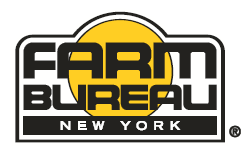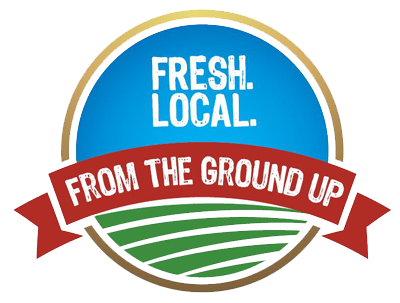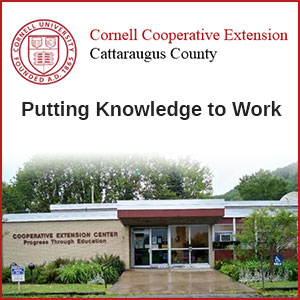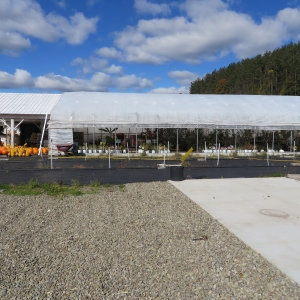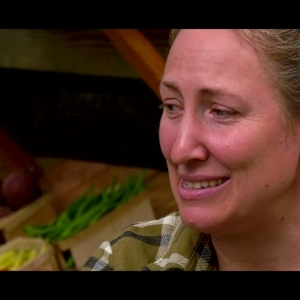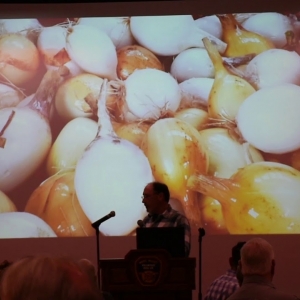Other Ag News:
(Washington, D.C., April 24, 2025) – U.S. Secretary of Agriculture Brooke Rollins visited the Hamm Institute at Oklahoma State University (OSU) with Secretary of Energy Chris Wright and Environmental Protection Agency Administrator Lee Zeldin for the Powering AI: Global Leadership Summit. The Cabinet members were joined by Representative Stephanie Bice and Representative Frank Lucas.
This year marks the tenth anniversary of Whole-Farm Revenue Protection (WFRP), a novel insurance product that offers farmers nationwide the option to insure the revenue of their entire operation, including crop, livestock, and nursery production, under a single policy. WFRP also rewards adoption of business practices that reduce risk with its premium discount for crop and enterprise diversification.
These features make WFRP the ideal insurance product for a wide range of farms including small and mid-sized farms, which are more likely to be multi-crop, direct-market systems. Just nine percent of farms with less than 50 acres are insured at a time when financial volatility and unpredictability of weather events makes access to a safety net more important than ever.
In this blog, the National Sustainable Agriculture Coalition (NSAC) analyzes the latest data in WFRP enrollment and coverage, revealing a heartening trend that recent improvements to WFRP are leading to steady gains. This is followed by several recommendations to propel this momentum, featuring needed improvements to both WFRP and the complementary Noninsured Crop Disaster Assistance Program (NAP).
National Enrollment is UpThe number of farmers enrolled in a WFRP plan rose to 2,256 in 2024 – the second highest participation in the program since 2018. Prior to 2024, WFRP enrollment had fallen from its peak by almost 35 percent in 2022, at 1,821 policies sold. Two years of increasing policy sales suggest that the bump in 2023 was not an anomaly, but the beginning of a new and favorable trend for the program.
322 more farmers enrolled in WFRP in 2024 than in 2022, counting both normal WFRP policies and Micro Farm policies. If this pattern of growth continues, WFRP is on track to break the sales record set in 2017 (2,833 sales) within two years.
Figure 1: WFRP and Micro Farm Policies Sold by Year Source: USDA, RMA Summary of BusinessThe uptick in enrollment is due to several improvements stewarded by USDA in recent years. First, USDA made programmatic improvements to remove some of the most common barriers to access. The Risk Management Agency (RMA) created the new Micro Farm option in 2022, which streamlines paperwork via the removal of burdensome expense report requirements and extends coverage to include post-production and value-added costs. The blog includes more information on the performance and changes to Micro Farm below.
Among other changes RMA later removed the expense report requirement for all WFRP policyholders, not just those enrolling in Micro Farm. Expense reporting previously required farmers to produce receipts for all transactions within a year, among other records, a standard which does not align with the records that many small farmers keep – especially not those selling directly to consumers at farmers’ markets or farm stands.
In addition, USDA began to invest in more active promotion of WFRP and Micro Farm in 2023. That year, the so-called “Roadshow” educated 17,500 farmers, crop insurance agents, and other attendees about the program with a series of virtual and in-person workshops. The latest move was to create a registry of crop insurance agents open to sell WFRP policies, organized by state. Finding an agent willing to sell WFRP policies is one of the most persistent challenges that prevent farmers from enrolling in federal crop insurance.
Liabilities and LossesIn 2024, WFRP covered more insurable revenue than in any previous year at $2.96 billion. A significant portion of that accelerated growth is most likely attributed to the enrollment of more farms with higher value, including larger farms. The growth correlates with RMA’s decision to increase the maximum insurable revenue for WFRP from $8.5 million to $17 million. That change went into effect in 2023, allowing more farms to participate in the program.
Figure 2: WFRP Policies Sold and Liabilities by Year Note: This graph does not include Micro Farm data.Source: USDA, RMA Summary of Business
In 2023, the program issued more indemnity payments to farmers that made claims than any year prior: $21.1 billion. Because farmers collectively paid $13.6 billion in premiums to enroll in WFRP, the program operated at a “loss ratio” of 1.55. This metric is used to determine whether the Federal Crop Insurance Program, and individual policies therein, are “actuarially sound”; a loss ratio of 1.0 reflects a breakeven point, where indemnities equal the amount of money farmers pay in premiums to enroll.
Loss Ratio = (Losses Due to Claims / Total Premium Earned) x 100
RMA is statutorily required to maintain the actuarial soundness of the Federal Crop Insurance Program. That means that the average loss ratio must be at or below 1.0 on a 10-year average. This balance guarantees that enough funds will be available to issue payments in years of extreme loss.
Figure 3: WFRP Loss Ratio by Year Note: This graph does not include Micro Farm data.Source: USDA, RMA Summary of Business
At 1.55, WFRP’s high loss ratio in 2023 is most comparable to 2019. That year, NSAC determined the loss ratio was due in large part to heightened losses in Washington state. That’s because 34 percent of all WFRP policies that year were sold and serviced in Washington, and its individual loss ratio at 2.13 was a heavily weighted outlier.
It appears that the loss ratio may again be attributed to the weight of individual states. With 705 policies sold (33 percent of the national total), Washington’s apple growers continue to lead in WFRP enrollment. Its loss ratio of 2.75 was once again a weighted outlier influencing the national average. For its part, California – the state with the second-highest enrollment in 2023 – exhibited a loss ratio just above the breakeven point, at 1.23, which coincides with the floods which inundated the Central Valley that year.
Figure 4: Average Loss Ratio 2015-2025 by Policy Type Note: This graph does not include Micro Farm data.Source: USDA, RMA Summary of Business
Ultimately, the average loss ratio of WFRP is in relative alignment with multi-peril crop insurance programs. Its comparatively small size makes it more susceptible to wide swings than other insurance programs. To illustrate, 1,850 WFRP policies were sold in 2023, compared to 271,244 Yield Protection policies, 155,538 Actual Production History policies, and 1.56 million Revenue Protection policies. The Law of Large Numbers suggests that greater participation in WFRP beyond Washington would neutralize the impact of sudden regional spikes on the program’s overall loss ratio.
Closer Look at Micro FarmThe Micro Farm option has emerged as a key to expanding WFRP enrollment in recent years. First created by RMA in 2022, Micro Farm was initially only available to farms with less than $100,000. The option streamlines paperwork via the removal of burdensome expense report requirements and offers additional coverage for value-added production and transportation.
Targeting only true “micro” farms, just 26 policies were sold in its inaugural year. The eligibility ceiling was too low for a majority of small and mid-sized producers, even though such barriers were just as, if not more, salient for these farmers. Responding to producer needs, RMA expanded the eligibility ceiling in 2023 to include farmers with a gross revenue up to $350,000, which incorporates all “small” farms as defined by USDA.
Figure 4: Micro Farm Policies Sold by Year Source: USDA, RMA Summary of BusinessMicro Farm enrollment leapt from 26 to 136 within just two years. Presently, that participation is most concentrated in Michigan, with 69 policies sold in 2024. The Micro Farm option requires less paperwork from both farmers and crop insurance agents, while adding coverage for post-production expenses that are especially pivotal for direct-marketing farm businesses.
Notably, RMA’s decision to eliminate the requirement for expense reports within Micro Farm became a proof-of-concept that enabled the agency to extend that to the rest of WFRP in 2024.
State BreakdownFirst glance at the map below reveals that Washington state is the point of origin for most WFRP policies sold since 2015. Zooming out, WFRP is most popular in the Pacific Northwest and surrounding region generally, with 13,639 sold collectively between Washington (7,211), Idaho (1,971), California (1,746), Oregon (1,046), Montana (618), and Colorado (1,047). Many of these states have a high degree of specialty crop production and niche markets. For this reason, it follows that Florida (968), North Carolina (881), and Michigan (850) are also among the states with higher-than-average WFRP enrollment.
Figure 5: WFRP Policies Sold 2015-2024 !function(){"use strict";window.addEventListener("message",(function(a){if(void 0!==a.data["datawrapper-height"]){var e=document.querySelectorAll("iframe");for(var t in a.data["datawrapper-height"])for(var r,i=0;r=e[i];i++)if(r.contentWindow===a.source){var d=a.data["datawrapper-height"][t]+"px";r.style.height=d}}}))}();The relative lack of WFRP enrollment nationwide visually conveyed in this map does not reflect ineligibility or even disinterest; just about any farm with at least three years of revenue history and less than $17 million in liabilities may be technically eligible for WFRP. Instead, it reflects that some barriers continue to keep WFRP from becoming an accessible and worthwhile program for the small, multi-crop, and direct-marketing farmers whose unique business structures are best suited for WFRP.
What’s Next for WFRP?The improvements to WFRP stewarded by RMA in recent years have reversed the trend of declining enrollment. They are a roadmap to what should be done to continue streamlining access, which is necessary to protect more American farmers from increasingly unpredictable weather and markets.
Recommendations to continue building upon the success of WFRP include:
- Expand Micro Farm eligibility to include all mid-sized farms with a gross revenue up to $1 million, as recommended in a contracted RMA report as well as the 2018 Farm Bill.
- Reform arbitrary limits to coverage, including the limit that only insures expansion of a farm up to 35 percent and leaves small, rapidly expanding farms underinsured. In addition, options are needed to calculate indemnities as historic revenue, lest bad years weigh historic averages.
- New compensation bonuses and metrics for crop insurance agents to encourage selling WFRP to non-insured farmers, in addition to annual updates to the list of agents selling WFRP policies.
- Improve NAP, as the only insurance-like product available to farmers with less than three years of history, to offer revenue-based coverage for participants and to offer an “on-ramp” for transition to WFRP enrollment once the necessary history is acquired.
The Whole-Farm Revenue Protection Program Improvement Act, introduced in June 2023 by former Senator Sherrod Brown (D-OH), included many of these provisions. They were included in former Chairwoman Debbie Stabenow (D-MI)’s Rural Prosperity and Food Security Act in late 2024. Most recently, Rep. Johana Hayes (D-CT-5), joined by her colleagues representing the state of Connecticut, re-introduced the Save Our Small Farms Act, which includes all the above provisions to improve both WFRP and NAP.
In closing, NSAC maintains that WFRP and NAP are the programs best positioned to reach non-insured farmers, including small to mid-sized, specialty crop, and multi-crop farms that sell to local and regional markets. We will continue to advocate for the improvements outlined above with USDA and members of Congress who are committed to keep farmers on the land.
The post Whole-Farm Revenue Protection Analysis: New Enrollments Reveal Path Forward appeared first on National Sustainable Agriculture Coalition.
The last episode of the Small Farms Radio podcast spotlighted West Branch Commons, an innovative land access project that allows beginning farmers to lease affordable farmland with built-in market logistics support. We heard from Tom Hutson, whose family owned the West Branch land for four generations, and why he chose to stop dairy farming and contribute the land to West Branch’s project. We also heard from farmer Sea Matías and program coordinator Rhiannon Wright on why they believe West Branch’s unique land tenure model is changing the landscape for beginning farmers. The newest episode of Small Farms Radio continues the story of West Branch. In episode 3, co-founders Tianna Kennedy and Francis Yu share how they collaborated to start West Branch, and their vision for how similar programs could transform the small and beginning farmer world.
Small Farms Radio · Episode 3 – Founding the West Branch Commons Part 2Kennedy and Yu currently serve as co-executive directors at the Catskills Agrarian Alliance, the non-profit that owns and operates West Branch. They met doing mutual aid work in New York City at the beginning of the COVID-19 pandemic. Tianna had been working for the Catskills Agrarian Alliance, along with directing the 607 CSA program. She had also been working in the land access space since 2013 with the Land for Good program, the Center for Agricultural Development and Education (CADE), and the Chester Agricultural Center. However, the projects were small and Kennedy felt that they were not reaching their full potential.
“What I discovered was that where those [past] projects were struggling was that there wasn’t really great local management of the project,” Kennedy said. “It was sort of just these people that were foisting farmers and investors together and then disappearing.”
Kennedy envisioned a new land access project at a much larger scale, with holistic local management that would support farmers in every aspect of their business. She realized she would need help with her ambitious plans; Yu joined the team, initially leading the charge to reform the financial aspects of these smaller land access projects. They eventually decided to aim for something bigger, and began to create the large, integrated project that would become West Branch Commons.
“They model they [previously] had no longer felt like the goal for us,” Yu said. “We started to explore the other organizational structures that made sense and really seemed to capture our values of reciprocity and stewardship and agroecology.”
They landed on the community land trust (CLT) model that would allow a non-profit to manage the farmland and keep leases affordable for beginning farmers. While CLTs are typically used today in the housing space to control rent for a community of residents, the model has deep roots in the agricultural world.
Yu also explained that their vision for West Branch Commons was to go further than just land; they wanted to provide farmers with a framework of resources that would not just get them started, but allow them to flourish in the long term.
“It’s an issue beyond land access,” Yu said. “How do we also develop a network of resources, a community? How do we access different markets so that our farm is viable, how do we access different neighbors so that we have the resources and tools that we wouldn’t be able to afford on our own?”
By partnering with organizations that provide logistics and distribution support, land management assistance, and community building, Yu and Kennedy have designed West Branch Commons to be holistic and participatory; it is for the community, and by the community. While they have been proud to perform this work in the non-profit space, they also believe that the West Branch model should be expanded and applied in the public sector in order to foster the growth of the agricultural industry.
“For the broader sustainability of the future of land access, there needs to be a give. And I think that needs to come from the federal government,” Yu said. “USDA needs to shift its focus to support land access via different policies that do conservation or provide […] accessible financing for new, young farmers or socially disadvantaged farmers. We can do this, but […] to continue to rely on foundations or philanthropists to provide that funding, I don’t think that’s sustainable.”
They think that these changes to the farmland tenure system could encourage more young people to get involved in farming. They also believe the West Branch model would benefit long-term environmental sustainability. The collective nature of CLTs fosters quality land stewardship and regenerative practices; Yu thinks this change in the relationship between humans and the land is long overdue.
“This [project] is coupled with the rapidly declining availability of farmland. I think the figure coming from American Farmland Trust is that New York State loses 51 acres of farmland a day,” Yu said. “This project reflects our relationship to land […] Our vision for the land is that we want to steward it and be able to develop a reciprocal relationship to it like Tom and generations of Tom’s family have […] our current systems have an emphasis on exploitation and extraction of land, of labor, and of resources.”
The farmers who operate on the Commons can feel the impact of Yu and Kennedy’s vision and hard work. Host Jamie Johnson asked Commons farmer Sea Matías of Serra Vida Farm what it feels like to be a beneficiary of the services of the non-profit.
“A hug,” Matías said. “I feel very supported […] I have developed a community and family here […] For someone to understand what I’m trying to do, and what the farmers of this Commons want to do, and what they’re looking for, and believing in, that is just incredible.”
Listen to the full episode to hear more about the founding of West Branch Commons, and what its founders hope the West Branch model can bring to the future of farming.
The post Founding the Commons: Small Farms Radio Dives into West Branch Land Access Project appeared first on Cornell Small Farms.
(Washington, D.C., April 22, 2025) – U.S. Secretary of Agriculture Brooke L. Rollins joined Senator John Hoeven, who serves as chairman of the Senate Agriculture Appropriations Subcommittee, Congresswoman Julie Fedorchak, Governor Kelly Armstrong, and North Dakota Commissioner of Agriculture Doug Goehring for a visit to North Dakota.
FOR IMMEDIATE RELEASE
Contact: Laura Zaks
National Sustainable Agriculture Coalition
press@sustainableagriculture.net
Tel. 347.563.6408
Release: Agriculture Resilience Act Advances Bold, Farmer-Driven Vision
National Sustainable Agriculture Coalition Proudly Endorses Critical Climate and Agriculture Bill
Washington, DC, April 22, 2025 – Today, on Earth Day, Representative Chellie Pingree (D-ME-1) and Senator Martin Heinrich (D-NM) introduced the Agriculture Resilience Act (ARA). The ARA outlines farmer-driven, incentive-based strategies for how the next farm bill can support farmer livelihoods and build climate resilience. The National Sustainable Agriculture Coalition (NSAC) is proud to endorse a bill delivering a bold vision for the future of agriculture. The ARA would adapt the Farm Bill to the current reality by ensuring conservation, research, renewable energy, and rural economic development programs empower farmers and ranchers who are eager to drive climate solutions on the ground.
Through the first hand experiences of the effects of increasingly extreme conditions including floods, drought, wildfires, and increasing pest pressures, farmers and ranchers know the fundamental threat that a changing climate poses to their livelihoods and the viability of agriculture. In response to the challenges facing producers nationwide, Representative Pingree and Senator Heinrich offer the ARA and express their commitment:
“From historic droughts and wildfires to devastating floods and extreme weather, America’s farmers are directly impacted by the climate crisis,” said Pingree, a longtime organic farmer and senior member of the House Agriculture Committee. “With the Farm Bill in limbo and the Trump Administration actively undermining farmers’ interests, bold legislation like the Agriculture Resilience Act is more urgent than ever. These goals are ambitious—but they’re achievable. By helping farmers adopt practices that boost resilience and profitability, this bill charts a path to not only create a more sustainable future for America’s agriculture sector, but ensure greater economic viability for our farmers as well.”
“New Mexico’s agricultural producers and rural communities rely on the health of our land and water to sustain their families and communities. They are also the first to feel the impacts of climate change. That is why we need to provide our farmers and ranchers with new tools to not only protect their land and way of life, but also be part of the climate solution,” said Heinrich. “I’m pleased to reintroduce the Agriculture Resilience Act, which sets a national goal of achieving net-zero emissions in agriculture by 2040 through farmer-led, science-based initiatives. I’ll continue working to bring our communities the tools they need to improve soil health, expand conservation programs, increase research into climate-friendly agricultural practices, and support on-farm renewable energy projects.”
In response to the introduction of the bill, NSAC issued the following comment:
“The ARA outlines key investments and policies needed in the next farm bill to support the long-term sustainability of our farms and food system. With the changing climate posing serious threats, the risks to our agriculture producers are growing fast. Across the country, farmers and ranchers already know which practices are the most effective for building strong, resilient operations. It is more important than ever to invest in their efforts to safeguard against climate stresses and to protect their land and livelihoods,” said Richa Patel, NSAC Policy Specialist.
The 119th Congress’ ARA commits to the same focus as previous versions by centering on important climate and agriculture solutions, including perennial practices like agroforestry, agrivoltaics that combine agriculture and renewable energy goals, and the breeding of regionally-adapted crop varieties and animal breeds. By offering both incentives and research in support of solutions on which sustainable farmers are already taking the lead, the bill expands opportunities for the establishment of strong, farmer- and community-led strategies for building farmer economic security while confronting the climate crisis.
The updated section-by-section can be found here.
###
About the National Sustainable Agriculture Coalition (NSAC)The National Sustainable Agriculture Coalition is a grassroots alliance that advocates for federal policy reform supporting the long-term social, economic, and environmental sustainability of agriculture, natural resources, and rural communities. Learn more: https://sustainableagriculture.net/
The post Release: Agriculture Resilience Act Advances Bold, Farmer-Driven Vision appeared first on National Sustainable Agriculture Coalition.
(Washington, D.C., April 22, 2025) – Today, U.S.
FARGO, ND - April 22, 2025 — Today, U.S. Secretary of Agriculture Brooke Rollins announced $340.6 million in U.S. Department of Agriculture disaster assistance to deliver relief to farmers, ranchers and rural communities impacted by natural disasters that have caused devastation across the country.
(Washington, D.C., April 21, 2025) – U.S. Secretary of Agriculture Brooke L. Rollins joined the 2025 White House Easter Egg Roll on the South Lawn alongside American egg producers.
(Washington, D.C., April 18, 2025) – This week, U.S. Secretary of Agriculture Brooke Rollins visited Central Pennsylvania where she toured Talview Dairy, participated in a farmer roundtable at Martin’s family farm, and visited the Bank of Bird-in-Hand mobile bank to discuss agricultural lending with community leaders. Secretary Rollins was joined by Senator Dave McCormick, House Agriculture Committee Chairman GT Thompson, and Representatives Dan Meuser, Rob Bresnahan, and Lloyd Smucker.
Pages
Signup for the Ag Newsletter
Get the freshest farm news, events and updates from in and around Cattaraugus County, NY at least once a month! Go signup!
Other ways to stay connected:
Get Involved in Farming
Resources for Starting a Farm in Cattaraugus County
Profile of Cattaraugus County soils
Agriculture Career Exploration
Questions about farming? Find out Who to Call

